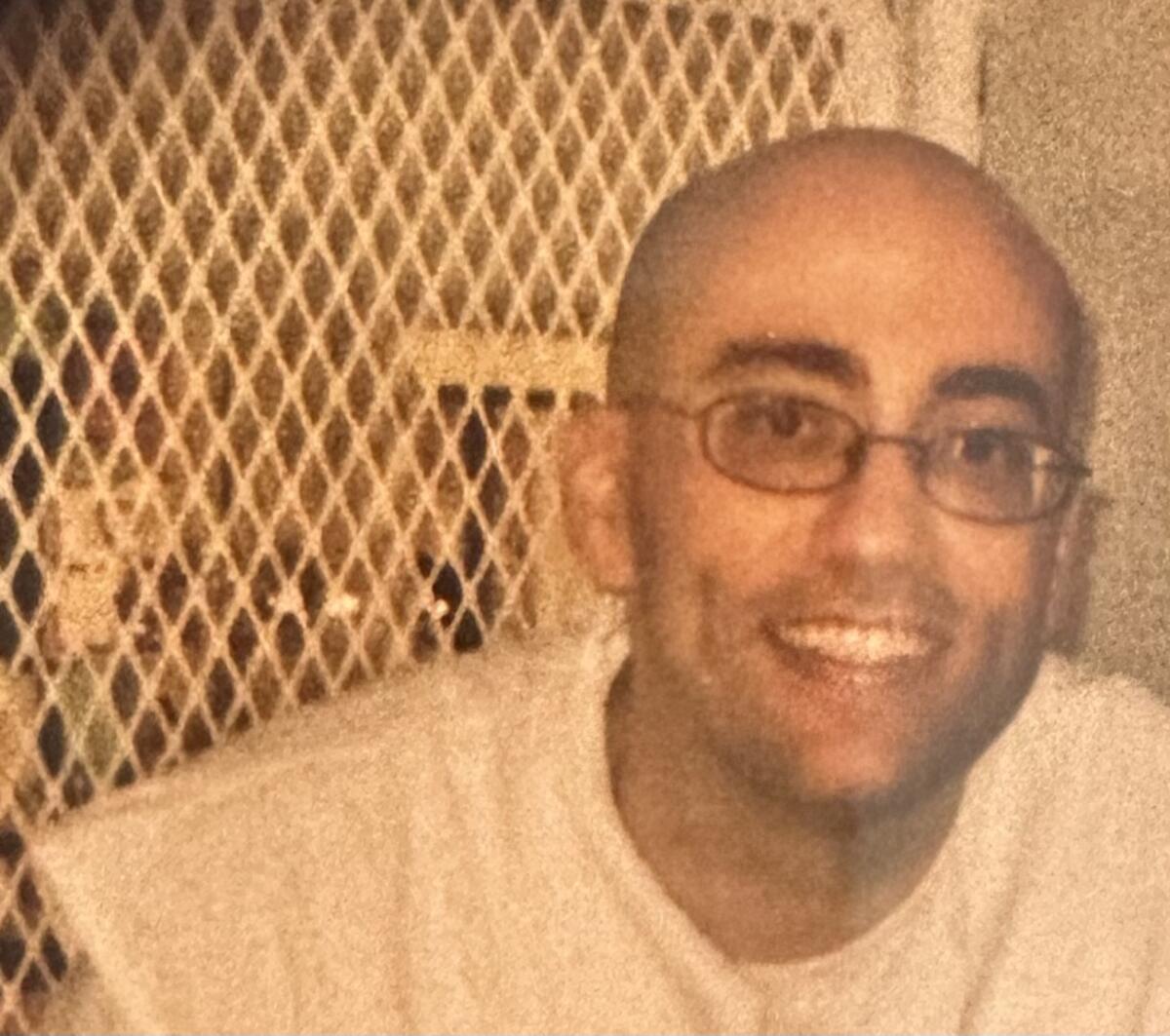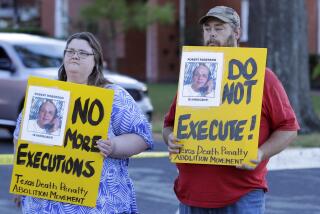Jedidiah Murphy and the evolving debate on mental illness and capital punishment

LIVINGSTON, Texas — The case that landed Jedidiah Murphy on Texas’ death row is not remarkable, at least not by death row standards. After a childhood of abuse and years in foster care, by his teens he had begun showing signs of severe mental illness, including hallucinations and dissociative blackouts. Soon, he began drinking to self-medicate.
It was during a blackout in the fall of 2000, he says, that he carjacked an elderly woman near Dallas. He shot her to death, which he does not deny. But he said he didn’t mean for the gun to go off. He spent the next two decades appealing his punishment — hoping to avoid the death chamber by arguing that he is not a dangerous man but rather a mentally ill one who’d accidentally fired a shot.
But there is one way in which his case has become an outlier: For several months, the 48-year-old has been scheduled for execution on Tuesday, World Day Against the Death Penalty, which global abolitionists have observed for two decades. As the nation’s use of capital punishment continues its decades-long decline, that’s an increasingly rare outcome, even in Texas.
Even rarer still: Murphy won a stay, upheld late Monday by the conservative 5th U.S. Circuit Court of Appeals. It was not immediately clear whether state prosecutors would again appeal.
Just over two decades ago, the state executed 40 people in a single year. So far, there have been five executions there in 2023. If Murphy’s death date held — an outcome even his victim’s daughter did not support — he would have been the state’s sixth execution in 2023.
A snapshot of the death penalty’s slow decline in the United States would be a blur, fading and indecipherable.
Some states have fully abolished the death penalty. Among those that have not, only a handful are carrying out executions — most of which are concentrated in the South. Others have struggled to obtain the legal drugs needed to carry out the procedure.
A few states have turned to alternative methods of execution. Courts have determined certain categories of people should not be executed. And progressive prosecutors in some counties have stopped using the death penalty — or at least stopped using it quite as much.
In California, there’s a moratorium on executions, though the state nonetheless accounts for about 28% of the roughly 2,300 nationwide death row prisoners nationwide.
More than 200 of those on death row are from Los Angeles County, which is one of just a few nationwide where the death row population has increased over the last two decades, according to the Death Penalty Policy Project, an organization focused on capital punishment. Even though Dist. Atty. George Gascón stopped pursuing the ultimate punishment, the county still has more condemned prisoners than any other in the country.
George Gascón has promised to make sweeping changes to the Los Angeles County district attorney’s office, but he will have to walk a tightrope between prosecutors who opposed his candidacy and activists promising to hold him accountable.
::
When Murphy arrived on Texas death row in 2001, there were so many executions the state sometimes scheduled two in one night.
“It seemed like every day, somebody was gone,” Murphy told The Times during a recent interview at the Polunsky Unit in East Texas. “I told my family I’d probably be dead in about three-and-a-half or four years.”
The use of capital punishment there peaked in 2000 — the year there were 40 executions. Nationally, it had reached a high point the year before, when federal data show 98 people were put to death.
That was the height of the tough-on-crime era. Things have changed since then — in courts and death chambers and district attorneys’ offices.
In some cases, a better understanding of forensics has helped exonerate the wrongfully convicted. And public support for the death penalty has fallen.
“The death penalty is disappearing from whole regions,” said Robert Dunham, director of the Death Penalty Policy Project. “You can now travel the whole Pacific Coast and never enter a state in which an execution will be carried out.”
Of the fewer than two dozen executions that still happen per year, most are concentrated in a few Southern states, including Alabama, Oklahoma and Texas.
Yet even in Texas, someone like Murphy wouldn’t necessarily get a death sentence if his crime were committed today.
Murphy was born in a small town northwest of San Antonio. His mother left when he was 4. Afterward, according to court records, he was raised by his physically abusive father for a time, then put into foster care — where, his lawyers say, he was sexually abused and starved.
Through it all, for as long as he could remember, Murphy said, he had frequent dissociative blackouts. Sometimes he heard voices, took on other personalities or hallucinated snakes that terrified him, according to medical records filed in court. He began drinking at a young age, and struggled for years with intense drug and alcohol use.
“I was in four mental institutions before I ever came here,” Murphy said, his angular face peering through the smudged glass of the death row visiting room.
During the interview, he spoke in a fast-paced drawl, with a quick — sometimes self-deprecating — wit that made it hard to imagine who he used to be. But the years of medical records left little doubt. As Murphy himself said: “I lost my mind.”
According to his lawyers, it was after years of struggling with suicidal thoughts that Murphy said goodbye to his family, then took a gun and forced 79-year-old Bertie Lee Cunningham to give him a ride.
He told The Times he doesn’t remember anything until the moment he came to — mid-crime. Panicked, he said, he forced Cunningham into the trunk of his car and accidentally shot her in the process.
During his trial, Dallas County prosecutors painted a different picture. They described Murphy as a killer trying to evade responsibility by claiming he didn’t mean to shoot Cunningham. Instead, they argued the shooting was intentional and called his memory lapses a “very convenient” part of a story that “made no sense.”
In 2001, a jury found Murphy guilty and sentenced him to death.
Today, a case like his might be handled differently. Courts and juries now commonly factor in abusive childhoods, past traumas and histories of serious mental illness that might make people less culpable for their crimes. That consideration wouldn’t magically render him innocent, but Murphy thinks it could have swayed a jury to send him to prison for life instead.
And as Katherine Black, one of the Texas-based lawyers handling his case, pointed out, death penalty law in the state has changed: At the time of trial, the jury could only pick between the death penalty and a lengthy sentence that would still allow for the possibility of parole.
“Life without parole wasn’t an option then,” Black said, “so the jury was instructed that he would be eligible for parole in 40 years.”
It wasn’t until 2005 that Texas became the last death penalty state to allow life without parole as an alternative to death.
Today, the politics of capital punishment also have begun to shift in some parts of the state. The top prosecutor for the county in which Murphy’s crime occurred — Dallas County Dist. Atty. John Creuzot — is one of the progressive prosecutors who has stopped using the death penalty quite as much.
His office declined to comment for this story, referring questions to the state attorney general’s office, which is handling the case. Prosecutors there did not offer comment.
::
It might seem logical that a decades-long decrease in executions would swell the nation’s death row population. Instead — in most places — the opposite happened.
That’s due in part to some of the same legal changes that led to the decrease in executions in the first place. Whenever the courts decided that certain categories of people couldn’t be executed — such as those who were too young, too intellectually disabled or too mentally ill — they were often given life sentences instead and taken off death row.
For instance, in 2005, after the U.S. Supreme Court banned executing people for crimes they committed as minors, then-Texas Gov. Rick Perry was forced to commute the death sentences of 28 prisoners.
Aside from that, some states — including Illinois, Colorado and Virginia — decreased their death row populations by abolishing the death penalty altogether.
Nationally, the number of people living under a death sentence went down, falling more than 37% by the start of this year from its peak of roughly 3,700 in mid-2001. Texas’ death row is less than half the size it was when Murphy arrived there in 2001. Over that same time frame, however, California’s death row population has increased by more than 12%.
Even before Gov. Gavin Newsom ordered the dismantling of California’s death chamber in 2019, the state rarely carried out executions. California hadn’t put to death more than one or two people in any single year since the early 1960s. So when a federal court halted executions in 2006 over concerns about the lethal injection protocol, it didn’t make that much difference in terms of the numbers.
The Condemned Inmate Transfer Pilot Program has moved more than 100 people off of death row at San Quentin State Prison and the California Central Women’s Facility and into other housing locations, according to the California Department of Corrections and Rehabilitation.
Instead, Dunham said, a slow-moving legal system prevented people from getting off death row even if they were wrongfully convicted or could prove they didn’t deserve to die.
“One of the big reasons California’s death row has not declined as much as everybody else is because the state fails to provide lawyers, so cases that would have been reversed haven’t made it through the courts,” Dunham said, pointing to a 2014 federal court opinion that outlined the scope of the problem in detail. “Death row prisoners languish literally for decades without counsel.”
Attorneys for the state did not respond to requests for comment.
At the same time, prosecutors across California kept asking for new death sentences, despite knowing they couldn’t be carried out. Since the turn of the century, Dunham said, California has accounted for one of every six new death sentences.
As a result, state data show, the California death row population continued to increase until 2015 — and Los Angeles County was one of the big contributors to that increase.
By 2019, an American Civil Liberties Union report noted, nearly a third of California’s death row was from Los Angeles, which today still has more condemned prisoners than any other county in the country — a disproportionate number of them people of color.
“Death sentences from Los Angeles are a stark illustration of the racism endemic in the death penalty,” Cassandra Stubbs, director of the American Civil Liberties Union’s Capital Punishment Project, told The Times. “In the last 20 years, there have been 94 death sentences in Los Angeles — only seven of those cases had white defendants.”
But things are beginning to change. In 2019, when Newsom took office, he announced an official moratorium on executions. The following year, Gascón, another of the progressive prosecutors, took over as district attorney and stopped pursuing death sentences in Los Angeles County.
And earlier this year, the state announced plans to dismantle death row and move prisoners now there into the general population, ultimately making death row more a symbolic designation than a physical location.
So far that hasn’t happened — but last week a California Department of Corrections and Rehabilitation spokesman told The Times the goal is to move everybody by spring.
::
In the final days before his now-stayed execution, Murphy’s legal team has been juggling a series of legal challenges including requests for DNA testing related to crimes he’d previously been accused of and for a brain scan that could shed light on his mental health problems and a challenge filed in state court raising questions about whether the state’s lethal injection supplies were damaged in a recent prison fire at the facility where executions take place.
His lawyers also filed a long-shot bid for clemency. A central piece of the 31-page plea sent to the Texas Board of Pardons and Paroles last month centered on the controversial issue of “future danger.”
One of the requirements for a death sentence in Texas is that the jury must agree the condemned person would be a future danger to society if given any punishment other than death. During Murphy’s trial, prosecutors said he was dangerous because he had a history of committing violent crimes.
In 1997, they said, Murphy had stolen a purse from one woman the same day he allegedly kidnapped and robbed another woman — who didn’t identify him until three years later, when she saw his face in the news.
But authorities never charged him and, unlike with Cunningham’s killing, Murphy said he was innocent in those earlier cases. His lawyers have argued that it was physically impossible for him to have committed crimes so far away from where he was that night, and that his hand prints didn’t match those found in the kidnapped woman’s car.
Still, prosecutors used the alleged 1997 crimes to convince the jury he was a repeat kidnapper who’d gone on to kill — and thus would be a lifelong danger.
“Not only was he not a serial kidnapper of women,” Black said, “but he committed this crime in the throes of a mental health crisis that came after years of trauma and abuse.”
That’s why Black argues Murphy deserves mercy. After sitting through the trial and combing through records and news clippings, Cunningham’s daughter agrees.
“They claimed he tried to kidnap another woman, but I don’t think she pointed the finger at the right person,” she said, asking not to be named due to safety concerns.
“We are hoping for clemency.”
On Friday afternoon, all seven members of the Texas Board of Pardons and Paroles rejected Murphy’s plea. Meanwhile, the courts denied most of his legal claims — except for one. On Friday evening, a federal judge in Texas halted the execution over concerns about whether Murphy was entitled to DNA testing that his lawyers say would prove he was not involved in the earlier crimes.
The state promptly appealed — but late Monday, the 5th U.S. Circuit Court of Appeals upheld the stay.
More to Read
Sign up for Essential California
The most important California stories and recommendations in your inbox every morning.
You may occasionally receive promotional content from the Los Angeles Times.













